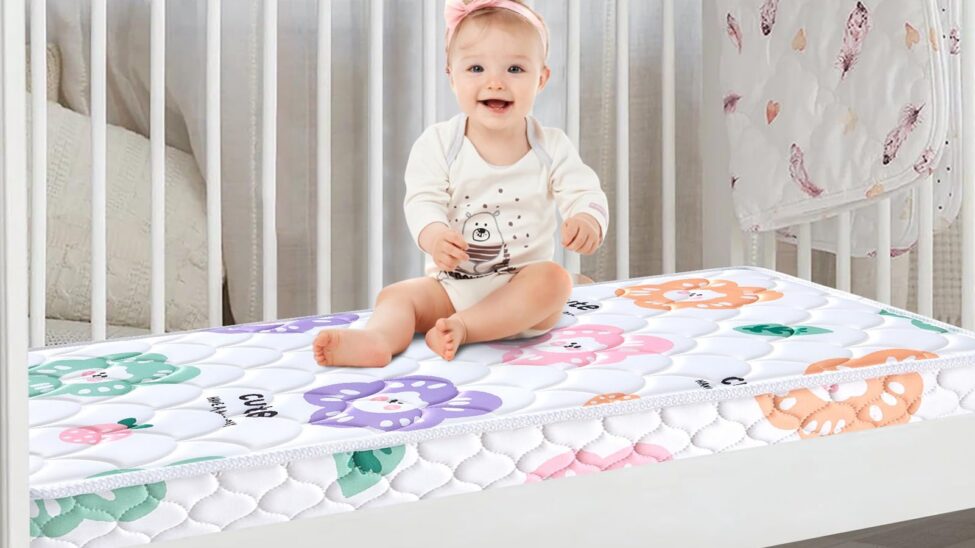
The Small Detail That’s Actually a Big Deal
Let me tell you something I didn’t expect: the mattress height in my daughter’s crib became one of those little things I kept revisiting, adjusting, thinking about — way more than I thought I would. It’s not just about convenience when you’re leaning in to lay them down. It’s about safety, timing, and being one step ahead of a growing, suddenly mobile baby.
When you’re running on three hours of sleep and trying to get through a nap routine without waking the baby, it might be tempting to leave the mattress where it is. But here’s the thing: babies grow fast. They roll, sit up, pull themselves to standing… all on their own schedule. And that comfy, easy-to-reach mattress height you loved in month two? It might turn into a hazard by month six.
Injury reports involving cribs have shown that incorrect mattress height — especially not adjusting it down soon enough — is a frequent factor in falls and accidents.
Following Baby’s Lead, Not the Calendar
Every crib manual has those recommended settings — top level for newborns, middle for babies who sit, lowest for standers. But life doesn’t follow a checklist. My son surprised us by pulling up in the crib at just over five months, and I was grateful I’d already lowered the mattress out of pure instinct the week before. That moment stuck with me: it’s not about age, it’s about ability.
Here’s how I approach it now, and what I share with tired parents I coach:
- Top setting: great for the newborn bubble when there’s no movement yet.
- Middle setting: once rolling or pushing up becomes a regular part of their day.
- Lowest setting: before pulling to stand happens — not after.
This is one of those things where “better a week too early than a day too late” really applies. Trust your baby’s development, not just the product guide.
Mattress height should be lowered before a baby can sit or pull to stand. Waiting until they already can increases the risk of falls.
The Safety Check You Can’t Skip
There are other details we sometimes overlook in the haze of bottles, diapers, and sleep regressions — but the mattress setting? That’s one I always circle back to when talking safety. There’s a reason even minimal movement in a baby monitor app makes us alert: our protective instinct kicks in.
Let’s put that instinct to use. Check your crib for:
- A firm mattress that fits snugly with no gaps on the sides
- Proper attachment to the crib frame — no shifting, squeaking or wobbling
- Secure locking mechanism when changing mattress height
It’s also worth checking crib slats and frame stability every time you adjust the mattress. A friend of mine didn’t realize the bolts had come loose after a height change — until the crib made an awful sound one night. No one was hurt, but it was a wake-up call in more ways than one.
Crib mattresses must be no more than 6 inches thick and fit within 1 inch of the crib sides to meet federal safety standards.
Our Family’s Routine: Real-World Adjustments
In our home, I’ve learned to build the “mattress check” into certain milestones. When we transition out of the swaddle? Time to lower. First time I see a new skill like rolling? Lower again. And when they’re standing like pros, we’re already on the bottom level.
It’s not always glamorous — I still remember crawling under the crib in pajamas with a flashlight because I dropped a bolt — but it’s worth it. The peace of mind I feel seeing my baby snoozing safely is what makes parenting at 3 a.m. bearable.
I always tell moms I work with: if your gut says it’s time to change the crib height, don’t wait for a milestone chart to agree. You know your baby better than any manual.
One Day, It’ll Be Time for the Next Bed
And yes, eventually they’ll outgrow the crib altogether. That moment — bittersweet as it is — usually comes not long after your baby starts climbing. (Yes, mine did it too, before I was ready.)
The crib is where so many of those early memories happen: first naps, midnight feedings, sleep training wins and long mornings. Keeping it safe isn’t just about avoiding falls — it’s about building a space that feels peaceful and protective for both you and your child.
Crib safety is dynamic. What was secure two weeks ago may not be today. Keep checking, keep adjusting. It matters more than you think.
So take five minutes this weekend. Peek into the crib. See where the mattress is. It might just be time to make a small change that brings a big dose of reassurance.


